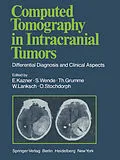The current book represents a distillation of the experience gained in diagnosis of intracranial tumors with computed X-ray tomography at the University Hos pitals of Berlin, Mainz, and Miinchen. To what purpose? Standard radiological techniques such as pneumoencephalography with lumbar puncture and cerebral arteriography with puncture of the common carotid artery are invasive proce dures which entail a certain amount of risk as well as discomfort for the patient. Furthermore, diagnoses made with these procedures rely primarily on indirect signs of an intracranial space-occupying lesion - such as displacement of the air-filled ventricles or of normal cerebral vessels. Only a few types of tumor are demonstrated directly with these techniques. In contrast, computed tomography demonstrates the pathology directly in almost all cases, and this with a minimum of risk and discomfort. In addition, normal intracranial structures are demonstrated, so that the tumor's effect on its surroundings can be evaluated. Today, almost a decade after HOUNSFIELD'S revolutionary invention, diagno sis of brain tumors without computed tomography is almost unthinkable, if not in fact irresponsible.
Inhalt
A. Introduction.- B. Classification of Intracranial Tumors.- 1. History and Problems in Classification.- 2. Types of Intracranial Tumors.- C. Technique of CT Examination.- 1. Computed Tomography Systems.- 2. Procedure in CT Examination.- 3. Analysis of CT Pictures.- 4. Intravenous Contrast Enhancement.- 5. Intrathecal Administration of Contrast Media.- D. Computed Tomography in Brain Tumors.- Collective.- Criteria for Evaluation of Computed Tomograms.- Type-Specific Diagnosis with CT.- 1. Autochthonous Brain Tumors.- a) Astrocytomas.- b) Anaplastic Astrocytomas.- c) Oligodendrogliomas.- d) Mixed Gliomas.- e) Diffuse Gliomatosis.- f) Glioblastomas.- g) Pilocvtic Astrocytomas.- h) Pontine Gliomas.- i) Ependymomas.- j) Subependymal Giant Cell Astrocytomas.- k) Nerve Cell Tumors.- l) Medulloblastomas.- m) Malignant Lymphomas.- n) Monstrocellular Sarcomas.- o) Histiocytomas.- p) Histiocytosis X.- q) Plexus Papillomas.- r) Tumors of the Pineal Region.- 2. Meningeal Tumors.- a) Meningiomas.- b) Malignant Meningiomas and Meningeal Sarcomas.- c) Hemangiopericytomas.- d) Primary Meningeal Melanomas and Leptomeningeal Melanosis.- e) Fibromas of the Dura Mater.- 3. Neurinomas.- a) Acoustic Neurinomas.- b) Trigeminal Neurinomas.- 4. Pituitary Adenomas.- 5. Tumors of the Blood Vessels.- Hemangioblastomas.- 6. Dysontogenetic Tumors.- a) Hamartomas.- b) Cavernous Hemangiomas.- c) CranioDharvngiomas.- d) Colloid Cysts.- e) Endodermal Cysts.- f) Lipomas.- g) Epidermoids, Dermoids, and Teratomas.- 7. Intracranial Tumors of Skeletal Origin.- 8. Locally Invasive Tumors.- a) Cavernomas of the Base of the Skull.- b) Paragangliomas.- c) Carcinomas of the Paranasal Sinuses.- d) Adenoid-Cystic Carcinomas.- e) Rhabdomyosarcomas.- f) Aesthesioneuroblastomas.- 9. Intracranial Metastases.- E. Computed Tomography in Processes at the Base of the Skull and in the Skull Vault.- 1. Base of the Skull.- a) Intracranial Space-Occupying Lesions Involving the Base of the Skull.- b) Metastases in the Base of the Skull.- c) Primarily Extracranial Tumors.- d) Miscellaneous Pathological Lesions of the Base of the Skull.- 2. Skull Vault.- F. Computed Tomography in Nonneoplastic Space-Occupying Intracranial Lesions.- 1 Inflammatory Processes.- a) Brain Abscesses.- b) Subdural Empyemas.- c) Focal Meningoencephalitis.- d) Chronic Stenosis and Occlusion in the CSF Pathways.- 2 Acute Demyelinating Diseases.- 3 Granulomas.- 4 Cysts.- a) Arachnoid Cysts.- b) Other Cysts.- 5 Parasites.- 6 Intracranial Hematomas.- 7 Vascular Malformations.- 8. Brain Infarction.- G. Computed Tomography in Orbital Lesions.- 1. Benign Tumors.- 2. Malignant Tumors.- 3. Inflammatory Processes.- 4. Malformations and Posttraumatic Lesions.- 5. Endocrine Ophthalmopathy (Graves' Disease).- H. Effect of Computed Tomography on Diagnosis of Neurological Disease.- References.
